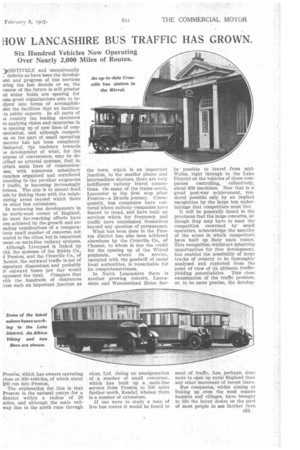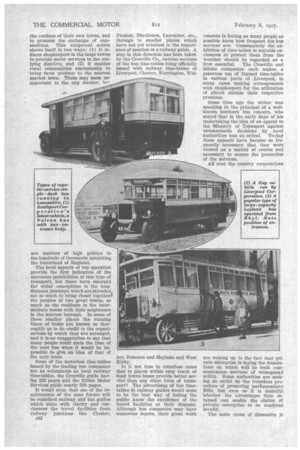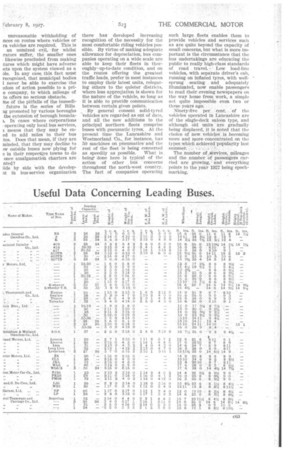HOW LANCASHIRE BUS TRAFFIC HAS GROWN.
Page 127

Page 128

Page 129

If you've noticed an error in this article please click here to report it so we can fix it.
Six Hundred Vehicles Now Operating Over Nearly 2,000 Miles of Routes.
30SITIVELY and unequivocally _ definite as have been the developLent and progress of bus services uring the last decade or so, the romise of the future is still greater ad wider fields are opening for losa great organizations able to inTpret into terms of accomplishnut the facilities that an inarticuLte public expects. In all parts of )e country the leading operators re applying vision and enterprise in le opening up of new lines of coraninication, and although conipetion on the part of small operating encerns has not been completely [iminated, the tendency towards le development of what, for the urpose of convenience, may be dearibed as arterial systems, that is, ertain main lines of communicaons, with numerous subsidiary ranches organized and correlated ccording to the peculiar exigencies f traffic, is becoming increasingly bvious. The aim is to unseal dead ads by linking them with the neighcoring areas beyond which there re other bus extensions.
In reviewing bus developments in he north-west corner of England, tie most far-reaching effects have con achieved by the growth and exending ramifications of a compareively small number of concerns, not ecated in the cities, but in important owns on main-line railway systems. . Although Liverpool is linked up vith the systems of the Ribble Co., vf Preston, and the Crosville Co.; of Ihester, the outward traffic is-not of mportant dimensions, and probably ;0 outward buses per day would .epresent the total. Compare that vith the hundreds of clearances 'ram such an important junction as Preston, which has owners operating close on 300 vehicles, of which about 200 run into Preston.
The explanation for this is that Preston is the natural centre for a district within a radius of 20 miles, and although the main railway line to the north runs through the town, which is an important junction, to the smaller places and intermediate stations, there are very . indifferent railway travel connections. On many of the trains north, Lancaster is the first stop after Preston—a 20-mile journey. Consequently, bus companies have ventured where railway companies have feared to tread, and have built up services which for frequency and traffie have established themselves beyond any question of permanence.
What has been done in the Preston dfstrict has also been achieved elsewhere by the Crosville Co., of Chester, to whom is due the credit for the opening up of the Wirral peninsula, where its service, operated with the goodwill of many local authorities, is remarkable for its comprehensiveness.
In North Lancashire there is another growing concern, Lancashire and Westmorland Motor Ser
vices, Ltd. (being an amalgamation of a .number of small concerns), which has built up a.
service troan Preston to 100 miles farther north, Kendal. whence there is a number of extensions.
If one were to study a map of live bus routes it would be found to be possible to travel from midWales, right through to the Lake District on the vehicles of three companies controlling, collectively, about 600 machines. Now that is a great post-war achievement, rendered possible only by an implied recognition by the large bus undertakings that competitors must live.
It will be generally found in the provinces that the large concerns, although they may have to meet the competition exercised by small operators, acknowledge the sanctity of the areas in which' competitors have built up their main routes. This recognition, whilst not debarring opportunities for free development, has enabled the possibility of large tracks of country to be thoroughly analysed and exploited from the point of view of its ultimate trafficyielding potentialities. This close examination of the traffic problem, or, to be more precise, the develop
ment of traffic, has, perhaps, done more to open up rural England than any other movement of recent times.
Bus companies, whilst aiming at linking up even the most remote hamlets and villages, have brought to life the latent desire on the pa rt of most people to see farther than • the confines of their own towns, and to promote the exchange of commodities. This reciprocal action shows itself in two ways: (I) It induces shopkeepers in the large towns to provide motor services to the outlying districts, and (2) it enables rural communities Conveniently to ' bring farm produce to the nearest market town. These may seem unimportant to the city dweller, hp are matters of high politics to the hundreds of thousands inhabiting the .hinterland of England.
The local aspects of bus operation provide the first indication of the enormous possibilities of this type of transport, but there have emerged far wider conceptions in the longdistance journeys, which are intended, not so much to bring closer togethert the peoples of two great towns, so much as the residents in the intermediate towns with their neighbours In the nearest borough. In some of these smaller places the running times of buges are known so thoroughly as to do credit to the organizations by which they are arranged, and it is no exaggeration to say that many people could state the time of the next bus when it would be impossible to give an idea of that of the next train.
Some of the motorbus time-tables Issued by the leading bus companies are as voluminous as local railway time-tables, the Crosville guide having 228 pages and the Ribble Motor Services guide nearly 200 pages.
It would seem that one of the requirements of the near future will be combined railway and bus guides which state with clarity and conciseness the travel facilities from railway junctions like Chester, c62 Preston, Blackburn, Lancaster, etc., through to smaller, places which have not yet attained to the importance of mention in a railway guide. A. step in this direction has been taken by the Crosville Co., various sections of the bus time-tables being officially issued with railway time-tables of Liverpool, Chester, Warrington, Wid nes, Runcorn and Hoylake and West Kirby.
Is it not true in countless cases that to places within easy reach of busy towns buses provide better service than any other form of transport? The advertising of bus timetables in railway guides would seem to be the best way of letting the public know the excellence of the travel facilities at their disposal. Although bus companies may have numerous depots, their great work consists in letting as many people as possible know how frequent the bus services are. Consequently the exhibition of time-tables in suitable enclosures to protect them from the weather should be regarded as a first essential. The Crosville and Ribble companies each makes a generous use of framed time-tables in various parts of Liverpool, in many cases making arrangements with shopkeepers for the utilization of places outside their respective premises.
Some time ago the writer was speaking Co the principal of a wellknown northern bus concern, who stated that in the early days of his undertaking the idea of an appeal to the 'Ministry of Transport against -unreasonable decisions by local authorities was an ordeal. To-day these appeals have become so frequently necessary that they were viewed as a matter of course and necessary to ensure the protection of the services.
All over the country corporations are waking up to the fact that private enterprise is laying the foundations on which will be built communication services of widespread utility. Some authorities are seeking an outlet by the troubious procedure of promoting parliamentary Bills, but even so it is doubtful whether the advantages thus obtained can enable the claims of private enterprise to •be rendered invalid.
The main cause of dissension is
unreasonable withholding of sees on routes where vehicles or ra vehicles are required. This is an unmixed evil, for whilst rators suffer, the smaller ones likewise precluded from making tures which might have adverse :cis upon the system viewed as a ale. In any case. this fact must recognized, that municipal bodies I never be able to exercise the adorn of action possible to a prie company, to which mileage of te offers no serious obstacle. Me of the pitfalls of the immedifuture is the series of Bills og promoted by various boroughs the extension of borough bounda1. In cases where corporations operating only local bus services, s means that they may be enad to add miles to their bus tes. Does that mean, if they are minded, that they may decline to mw outside buses now plying for a in their respeckve towns to do once amalgamation charters are ntecl?
Ude by side with the developrit in bus-service organization there has developed increasing recognition of the necessity for the most comfortable riding vehicles possible. By virtue of making adequate allowance for depreciation, bus companies operating on a wide scale are able to keep their fleets in thoroughly-up-to-date condition, and on the routes offering the greatest traffic loads, prefer in most instances to employ their latest units, relegating others to the quieter districts, where less appreciation is shown for the nature of the vehicle, so long as it is able to provide communication between Certain given points.
.._ By general consent solid-tyred vehicles are regarded as out of date, and all the new additions to the principal northern fleets comprise buses with pneumatic tyres. At the present time the Lancashire end Westmorland IN.,. for instance, has 50 machines On pneumatics' and the rest of the fleet is being converted as speedily as possible. What is being done here is typical of the action of other . bus concerns throughout the north-west country. The fact of companies operating
such large. fleets enables them to provide vehicles and services Slid as are quite beyond the capacity of small concerns, but what is more important is the circumstance that the bus undertakings are educating the public to really high-class standards of road travel. • Low load-line vehicles, with separate driver's cab, running on inflated tyres, with wellsprung seating and adequately illuminated, now enable passengers to read their.evening newspapers on the way home from work, a simple act quite impossible even two or three years ago. .
Ninety-five per.. cent. . of the vehicles eperated in Lancashire are of the single-deck saloon type, and although old units are gradually being displaced, it is noted that the choice of new. vehicles, is becoming more and more concentrated on the types Which achieved popularity last summer.. ....•
The number of services,. mileages and the number of paisengeks carried are growing, and, everything points to the year 1027 being epochmarking.




































































































































































































